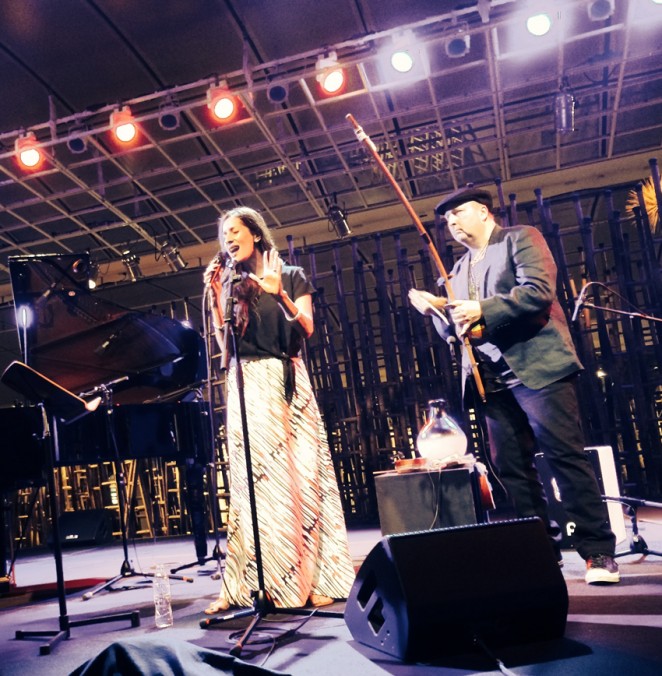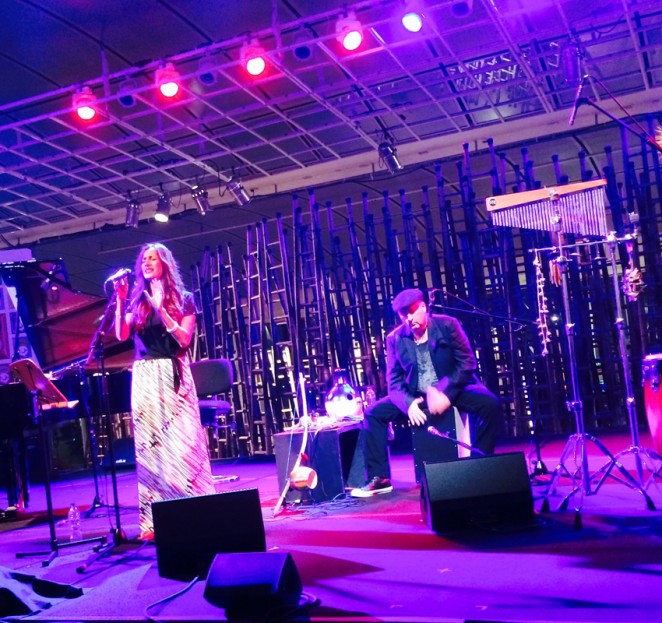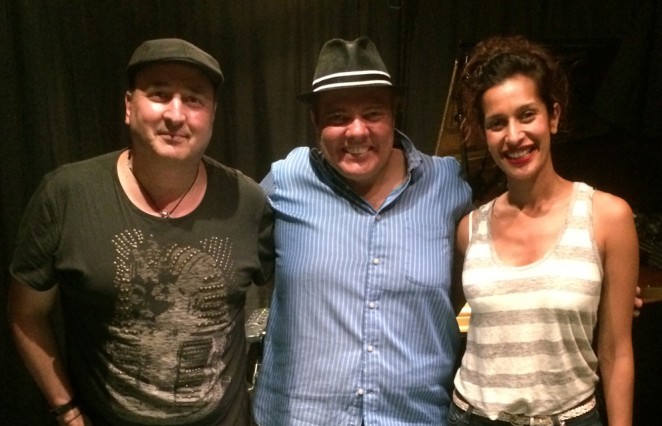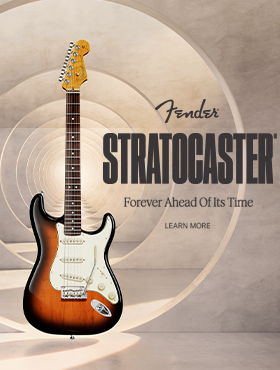 Alex Pertout and Nilusha Dassenaike, who record and perform as Alex & Nilusha, have just released their second album ‘Tales To Tell’, a high quality, rhythmic and melodic, world music feast. The duo kindly invited Australian Musician’s Greg Phillips into their home to discuss the creation of the album and their musical paths to date.
Alex Pertout and Nilusha Dassenaike, who record and perform as Alex & Nilusha, have just released their second album ‘Tales To Tell’, a high quality, rhythmic and melodic, world music feast. The duo kindly invited Australian Musician’s Greg Phillips into their home to discuss the creation of the album and their musical paths to date.
 Alex Pertout is not only a world-class percussionist and composer but also a keen percussion historian and teacher. Pertout’s percussion credits can be found on countless significant Australian recordings by Little River Band with John Farnham, Daryl Braithwaite, Hunters & Collectors, Mondo Rock, Powderfinger and Goanna among hundreds of others. He has appeared in numerous television bands, worked on major film soundtracks, live theatre productions, is part of the Australian Art Orchestra and is a Senior Lecturer and Head of Contemporary Music Jazz & Improvisation at the Faculty of the Victorian College of the Arts. His partner, Nilusha Dassenaike is an incredibly gifted vocalist, songwriter, arranger, enthusiastic musicologist and also lectures at the Victorian College of the Arts. Together as Alex & Nilusha, they are an amazing recording and performing duo utilising their South American and Sri Lankan backgrounds to blend music worlds into a captivating mix of jazz, soul, Latin American, Southern Asian and Eastern uplifting rhythms. Their recently released second album, ‘Tales To Tell’ is the true embodiment of the world music genre, not only showcasing rhythms from around the globe but literally recorded around the world. It also features respected musicians from all points of the compass too. But what are the origins of this album? Australian Musician asked the talented duo.
Alex Pertout is not only a world-class percussionist and composer but also a keen percussion historian and teacher. Pertout’s percussion credits can be found on countless significant Australian recordings by Little River Band with John Farnham, Daryl Braithwaite, Hunters & Collectors, Mondo Rock, Powderfinger and Goanna among hundreds of others. He has appeared in numerous television bands, worked on major film soundtracks, live theatre productions, is part of the Australian Art Orchestra and is a Senior Lecturer and Head of Contemporary Music Jazz & Improvisation at the Faculty of the Victorian College of the Arts. His partner, Nilusha Dassenaike is an incredibly gifted vocalist, songwriter, arranger, enthusiastic musicologist and also lectures at the Victorian College of the Arts. Together as Alex & Nilusha, they are an amazing recording and performing duo utilising their South American and Sri Lankan backgrounds to blend music worlds into a captivating mix of jazz, soul, Latin American, Southern Asian and Eastern uplifting rhythms. Their recently released second album, ‘Tales To Tell’ is the true embodiment of the world music genre, not only showcasing rhythms from around the globe but literally recorded around the world. It also features respected musicians from all points of the compass too. But what are the origins of this album? Australian Musician asked the talented duo.
Who were your musical heroes growing up?
Alex: Lots of heroes, but they also change and develop over time. I grew up listening to the Santana band, and the Santana band helped me discover a lot of other people. During their ‘Caravanserai’ era for example they were playing pieces such as ‘Stone Flower’ by the great Brazilian composer Antonio Carlos Jobim, so I had to find out more about Jobim, they were playing ‘Welcome’ by John Coltrane and so it made me enquire about Coltrane’s work and so on. Then there was an album Carlos Santana recorded with John McLaughlin, the band’s connection with Tito Puente’s music, tracks such as ‘Oye Como Va’, as a 14 year old boy listening to these sounds, it really opened my eyes and my musical world. The early Sergio Mendes records were inspirational for me and so was the incredible artistry of Miles Davis. Later I also discovered Chick Corea, Herbie Hancock, Weather Report, Pat Metheny and as you keep listening you keep discovering, Richard Bona for example, I just love his productions, wonderful albums. To relate a connecting encounter, we were in New York walking to a place and instead of going a certain direction we turned walked the opposite way and walked right into this tiny jazz club in the Village. Sitting at the bar was Richard Bona, we approached him as we actually had opened for him at the Recital Centre in Melbourne many years earlier. He told us that he was playing at this club for next three nights, so we ended up at that club every night, it was beautiful. We had a chat and asked about the possibility of discussing areas such as recording and production with him. He then invited us to his studio in Brooklyn where he played material he was working on and discussing the various ways he records and arranges his wonderful productions, it was a revelation and also a confirmation of the areas I admire and follow and what a way to spend time with an artist you admire, it was incredible.
Nilusha: He is somebody that both of us admire. For the same reason and for different reasons. On every album he does a beautiful vocal arrangement for one voice (his) and will overdub gorgeous, luscious harmonies. On our new album, the track ‘Sapphire’ I wanted to do a piece in homage to that or reflected that notion. What was really striking was how open and giving he was of information.
A: He was discussing recordings areas as an engineer would, like if you record a vocal here and you double it up, then I would normally do this and so on, you know after listening to his records so much, it was rather surreal to be there, in his environment, it was an amazing experience for us as we have listened to his music for years, and he was so generous and helpful, a beautiful man and an outstanding artist.

Nilusha, growing up in Melbourne, were you surrounded by music? Was anyone else in your family a singer?
N: Not really. My dad was in a like a little rock band when he was a teenager but never had any formal training. We used to listen to a lot of music and he was interested in jazz and fusion. I guess I grew up listening to variations of jazz. He used to make me listen actively to music and isolate instruments as we listened. He’d say can you hear what the bass is doing? Can you hear what the keyboardist is doing? You know, it was deeper listening, not just hearing the stuff on top. So that informed the way I listen to music. That kind of listening helps you with your aural training and what the roles in an ensemble are. But nobody in my family has gone on to become a professional performer.
You have an amazing vocal capacity but you don’t feel the need to sing ALL the notes. It’s more about the song. Is that fair comment?
N: Ultimately yeah. I see it in terms of what’s appropriate. I think that comes with maturity. If you had heard me when I was younger, everything had to be out there and big. I had a lovely mentor when I was coming up, Andy Sugg, he’s a beautiful jazz saxophone player and I happened to do a fill in gig with him one night, which led to many years of performing together. He really mentored me through learning jazz repertoire and how to be a better musician. He sat me down one day and said, look I get it, you just want to explode on every song and he said you could kind of take it back a little bit and choose the areas where you can do that. I still didn’t get it at the time but it has come through playing experience. He thought the sky was the limit for me, which was really lovely. But yes, I think about what is appropriate for the song and for the moment.
On the album there are a couple of variations on Sri Lankan folk songs. Do many explore those Sri Lankan folk songs and is it actually something that’s OK with the community to meddle with the tradition?
N: In a word yes … because Sri Lankan folk music is so obscure that a lot of Sri Lankans don’t even know about it. It is quite rare to hear Sri Lankan folk music let alone the blending of Sri Lankan folk music with Australian jazz.
It’s buried beneath the political and religious forces, it’s also a social thing. A lot of the folk tunes came from and are performed by practitioners from traditional drumming families and they are from a lower caste of the Sri Lankan social hierarchy. This stuff is centuries old. I mean the social hierarchy has now disbanded. They have now set up courses in universities that teach a little bit of the folk music. But still, a lot of the music which is taught in Sri Lanka is Indian music, particularly northern.

A: Nilusha completed a Masters of Philosophy in Music at the ANU and her research was based on Sri Lankan folk music. We travelled to Sri Lanka a couple of times and we visited traditional music makers, drummers and vocalists, all involved heavily in the continuous development and promotion of folk music, so Nilusha has this incredible background due to her extensive and serious research. Nilusha has an album to be released soon which I have produced and which is inspired by that tradition, it is titled ‘The Lotus Verses’. And if I may say, it gives Nilusha a really special place, because apart from being a very gifted and versatile contemporary vocalist covering an array of genres, she has also developed and has incorporated this special Sri Lankan style in her own way, which is rather unique, a beautiful sound.
And Alex, you grew up in Chile?
A: I grew up in Chile but what took place in my development, was that we moved to Italy when I was about 11 years old. While in Italy one of the things I still remember to this day is that I used to listed to the national Italian radio RAI that had a short daily program that played Latin American music, now I don’t know why an 11 year old boy was listening to this radio station and recording the programs on a daily basis, I was kind of developing the future area of research already. I used to tune in every day and they would play about fifteen minutes of Latin American music, the host was also incredibly knowledgeable about the styles and the artists and they range from Sergio Mendes to Tito Puente, Santana, Violeta Parra, Perez Prado, Mon Rivera, Chilean music, Peruvian, Brazilian, Cuban, Paraguayan, Argentinian and that is where I heard for the first time many of the instruments I have been researching and developing skills on now for decades. Then after we arrived in Australia I kept the interest and started learning conga drums, Afro Cuban, Caribbean and Afro Brazilian rhythms, soon after I was playing in bands. Later I developed my skills further incorporating some orchestral percussion instruments and I began to work as an all-round percussionist working with television orchestras, sessions, films, etc. my interested were always fairly broad ranging and so I kept on learning more and more about diverse percussion techniques from around the world. In 1996 as a member of the Australian Art Orchestra we toured India, which in turn led me to a new area of rhythmic development. This research of mine has always being wide in range, international, it also has led me back to my Chilean roots and styles from the Andean region. As an example on our new record, the first track ‘Nothing To Hide’ has a very Andean sound and I even play the zampoñas or pan flutes on the first track, which come from that region of north Chile, Peru and Bolivia.
I am also currently really interested in the mbira, which is an African thumb piano. I started researching the mbira and found this particular version from Zimbabwe called the nyunga nyunga mbira which I love and have started to develop skills on this instrument, as a matter of fact it features on a few tracks but specially on our version of two traditional tunes ‘Nemamusasa / I Gave my Love A Cherry’. This song closes the album.
See Alex and Nilusha play ‘Nemamusasa’ / ‘I Gave My Love a Cherry’ below
The album TALES TO TELL was recorded all over the world. Was that the idea from the start?
A: Not really, it just developed in that fashion consequently recording parts in the US, Cuba, Argentina and England. We recorded tracks and then as I was building them a particular person would come to mind. Edsel Gomez for example who plays the captivating piano solo on ‘Nothing To Hide’, well we saw him years ago with Dee Dee Bridgewater and he was outstanding, then we met him in Singapore while we were there for the Mosaic Music Festival and we struck a conversation, as we were developing this track I kept thinking about his playing and how it would suit this piece and when we travelled to New York we contacted him and arranged a recording session, his contribution is superb. Another example is when we started recording Nilusha’s ‘The King’s Lament’ I kept hearing my friend Hossam Ramzy, a remarkable Egyptian percussion master based in London on the track. I kept hearing his beautiful touch on the Egyptian tabla in the song. The funny thing is that after I asked him to play on the track, he proceeded to record in his London studio and sent me a whole lot of parts but no Egyptian tabla. So I asked “Hossam do you mind sending just one more file featuring yourself on the Egyptian tabla on this track?” He said, “well Alex, of course you are the producer, you are hearing that sound on the track, I will record that part for you and send it,” and it’s perfect for the song. A funny thing happens to me when I delve into producing a record and it’s probably a common producer thing, you are listening to the tracks constantly, for hours and hours as you record, you go to sleep and you are still hearing the songs and you can hear the people that should be on the tracks, you are kind of already there. I was already hearing Hossam playing on the track, so when he finally plays the part and we listen back, it’s just plain obvious to me that it was always going to work beautifully.
N: I don’t think that is a common thing. I think that is part of Alex’s gift as a producer and percussionist. He hears these ideas in advance. That kind of vision is unique. Working with Alex is almost like watching a jigsaw puzzle come together. I have a clear idea of the concept through the composition and arranging, but Alex takes the elements and shakes it all up then starts laying it out piece by piece. At times I’ve really questioned where he’s heading but I have learned to trust him.
A: When I am working in the studio on a particular song I can usually hear the final outcome with the correct parts, I am already hearing the parts and events before they get printed as they say. Maybe all these stems from decades of working in studios doing sessions contributing to records of all types, being able to hear it at a bare stage and constructing it in my head before playing a note. On my productions I could hear Hossam play on the track already, I could hear Paul Grabowsky play on the tracks before he even played a note. I understand the capabilities, the sound, the knowledge their playing will bring and how well it will all sit on the tracks. In the case of Paul, I mean I have known him for decades, we’ve played together in the Art Orchestra for more then twenty years, I just knew it was going to be amazing, the first track we did was one take, an outstanding performance.
Do you like to do a lot of vocal takes Nilusha?
N: Sometimes if you do it again and again you can’t quite capture the essence or the spirit of the first take. I definitely fix things if I feel that is not quite right or didn’t like a part. I’m quite particular and so is he. With the backing vocals, I arrange and write all the parts and I’m very particular on which parts are the most prominent parts and the way they are mixed. I like to hear certain sounds and colours. I guess that’s my thing. I hear backing vocals in a section here and backing vocals there and I like to recreate what I am hearing in my head.

For the track ‘Clear Water’, you recorded some street traffic in Cuba
A: Whenever we travel, I always take my portable digital stereo recorder and as I walk around I love to record around the streets. In Havana the atmosphere was just beautiful, vibrant atmosphere to record. I ended up using some of my street recordings at the beginning of this track which gives it an immediate ambience. This track features a special friend, the great Tom E Lewis on didgeridoo and vocals. We have spent a bit of time working on projects together. I organised a recording with him in a large room at the college which I set up with a couple of mics and proceeded to record these parts with him, it was incredible. I am recording, eyes closed, mesmerized by his sounds, half way through the piece I look up and he is walking around the room, complete absorbed in the moment, completely taken away by the track, it was magical, a special moment indeed.
How did American guitarist Mike Stern end up on the album?
A: I recorded an album many years ago and asked him to participate on a track. There was an opportunity this time around as he was coming to the Melbourne International Jazz Festival and a dear friend Frank Corniola was bringing him out. I enquired via Frank whether we could get Mike interested in participating on three songs on the album. We then sent him charts and basic demos of the songs. By the time he arrived in Melbourne, he was ready and completely engrossed in what we had to do in the studio. He was an incredible guest, playing all the parts beautifully, then coming up with other ideas for extra guitar parts, a rhythm guitar part here and there, an extra line here, we recorded and used everything he played. We saw him a few days later after his concert and he was eager to do more! He was telling us how he had some time a few days later to do some more or fix anything that might have not quite worked. And that shows you the man that he is, the professional stance he takes. On the session we organised we were in the studio till late at night and he was so engrossed, we could have stayed up all night recording, that was the vibe with him in the studio. We saw him again in New York months later, a few times and he was still raving about the songs, how great the recording sounded and how much he enjoyed the songs.
N: It was so great for me to sit in the studio and watch how he works. I haven’t done the amount of sessions that Alex has done but I’ve done a few. There are a handful of people I know who have this unbelievable musicality and attack and he is definitely one of them. Paul Grabowsky is another. Both of those sessions were like going to school for me. Alex is like that absolutely and Raymond McDonald, a Scottish jazz improviser and professor. There’s just this no apology, bang, here I am and this is how it goes. There’s a wonderful attack in the playing and an unbelievable amount of knowledge and creativity that they bring to the session.
What are the plans for this album now? Do you hope to tour it overseas?
A: We would love to do that and we are trying ways to develop connections to arrive at the international area. We will try and promote it as widely as we can. We are already getting airplay on the ABC and other stations like PBS. We would love to get into an area where we could get management who could look after our project and look at the big picture, international avenues. We were invited to the Mosaic Music Festival in Singapore this year and it was great, would definitely love to do more performances of that kind.
Are you thinking about the next Alex & Nilusha recording already?
A: Yes we are, we have recorded lots of things, we are always writing and recording. I also have a percussion based album that I have been completing for some time, in the style of the track ‘Clear Water’, featuring lots of percussion instruments in diverse rhythmic styles and in solo improvised configurations. Nilusha and I have also been working on a new more experimental type of album, free improvisation, atmospheric, in a creative and open type of area, in the moment performances. We have recorded a couple of tracks with Scottish saxophonist Raymond McDonald already and we are about to record a couple with trumpeter Miroslav Bukovsky and guitarist Geoff Hughes. We would like to release that record out of that at some stage soon, not as an ‘Alex & Nilusha’ record, but as a diverse creative project. Nilusha, as mentioned earlier has a solo record coming out called ‘The Lotus Verses’ and I also have a couple of back catalogue releases which our label will publish soon. A few years ago Nilusha and I created ‘Whispering Tree Music’ our own record label which releases projects distributed by The Planet Company/MGM through physical cds and digitally and internationally online through all the possible channels. We are slowly building this label’s catalogue for which we have creative control and are extremely happy about this development for our artistic endeavours.
http://www.alexandnilusha.com/
http://whisperingtreemusic.com
Also Nilusha launches her new solo CD Lotus Verses at The Spotted Mallard on October 29


